River Parrett Twin CIPP Pressure Lining Renovation (2021)
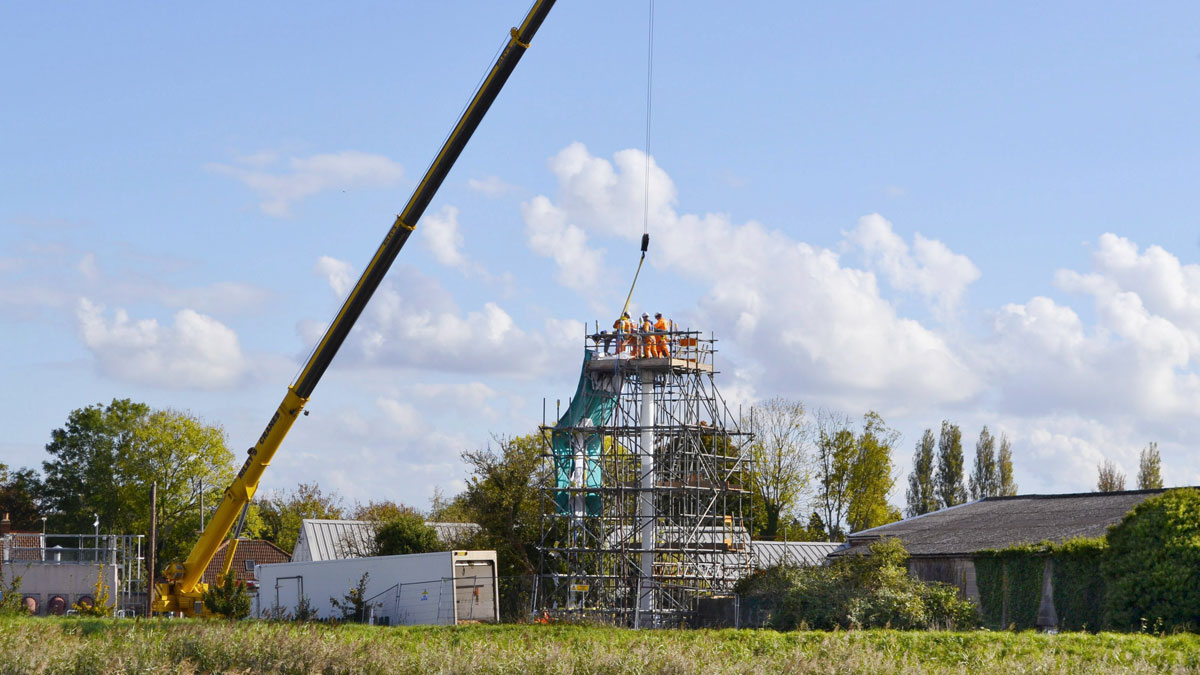
Eversion tower with levee in the foreground - Courtesy of Wessex Water
Large diameter rising main deterioration has become a big capital expenditure because of the risk of major infrastructure failure. The costs of repairing these assets in the event of failure are likely to be very high and characterise a large problem for water and sewerage companies in the UK. Wessex Water’s critical crossing review had identified the River Parrett twin rising mains in Bridgwater as medium to high risk of bursting with a high consequence, resulting in severe environmental pollution events and large operational disruption. The crossings were originally built in 1976 and were replaced in 1981 with steel pipe construction. The River Parrett passes through the town of Bridgwater in Somerset and discharges into the Severn Estuary, which is subject to a 13-15m high tidal range, one of the highest in the world. The twin mains are of 450mm steel inverted syphon rising mains with a number of 22.5 degrees bends. They convey flow from Bristol Road Sewage Pumping Station (SPS) to the Chilton Trinity Water Recycling Centre (WRC) crossing under the River Parrett, with a shallow depth below bed level.
Studies
An initial option study was undertaken and concluded that wholesale replacement of the rising mains would be extremely challenging both technically and financially, due to the bed and embankments geology. The existence of a deep artesian bed of gravels within the proposed catenary of drive was further complicated by a tortuous potential drill path under Larssen sheet piled walls supporting both levee embankments. The initial concept of directional drilling two new replacement mains raised concerns over the possibility of ‘frac out’ in the gravels and loss of drilling fluids and steerage. In addition, the launch sites for the drilling were very confined, and to locate the drilling rigs, a private house would require purchase and demolition. This also complicated the positioning of any HDPE lines for insertion, due to the A38 (Bristol Road) passing the site.
Alternative options were therefore considered including cured in place pipe (CIPP) lining. It is known that there have been relatively few CIPP pressure liners installed by the UK water industry since their development in the Far East in the 1980s, and at the present there is no recognised international design standard for pressure liners.
Wessex Water’s Sewer Rehabilitation Team and their framework contractor Onsite Ltd explored the alternative concept of a CIPP pressure lining and highlighted the need to line the mains whilst they were fully surcharged, to avoid catastrophic floatation of the steel mains at low tide. This would require the CIPP to be delivered with submarine considerations, displacing the water surcharge as the liner went, believed to be a first in the UK.
The River Parrett twin rising mains assessment & enabling works
The internal condition of the twin mains was unknown and surveys were required to assess the lining feasibility, to confirm the internal diameter, any deposits within the pipe and to retrieve samples of pipe for testing. Flows from the sewerage pumping station (SPS) to the water recycling centre (WRC) had to be maintained at all times, and the potential of redundancy was available to us if a fully functioning crossover between the two mains was constructed allowing diversion of flows. This required some enabling civils whilst recognising concerns that the mains were expected to be corroded and potentially fragile.
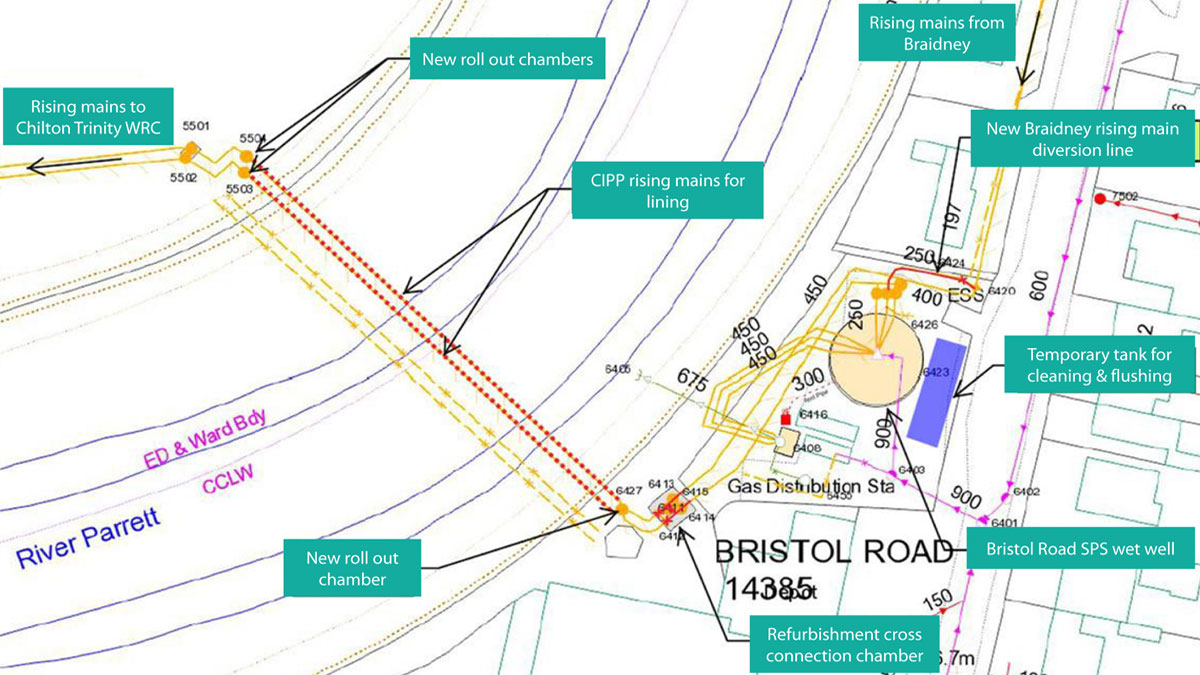
Project plan – Courtesy of Wessex Water
Two new shafts were constructed on either side of the riverbank with 1.5m long rollout sections installed in the pipelines to enable reciprocal flows for diversion dependent upon the main to be lined. The sections removed from the mains were then tested at an independent laboratory to determine the level of corrosion and the remaining wall thickness and thus a prediction of remaining life. The chambers were designed to have suitable dewatering sumps to allow for removal of residual foul flows and purging water.
Sonar survey was carried out from the new chambers to determine the internal diameter of the main and the type of bend installed. It highlighted the need to inspect and line the rising mains whilst they were fully surcharged, to prevent floatation of the steel mains due to low cover and fluvial tides. This was considered the most challenging aspect of the project. To establish the amount of deposits, the main was purged with clean water to allow a visual CCTV survey, with a low turbidity, while keeping the pipe full. Wessex Water have their own CCTV survey department and a suitable camera was to be deployed with resistance to over a bar of water pressure, suitable for their otherwise hostile environments.
Prior to CCTV surveys, hydraulic analysis had predicted sedimentation due to the low velocities in the Braidney main and these calculations were confirmed as the surveys identified one of the risers contained gravel deposits up to 30% of the diameter. These were predominantly cemented and varied in size from an estimated 3-50mm. The second riser, known as the Bristol Road Main, had little sedimentation. The sonar survey established the configuration of bend construction, perceived to be welded ‘Lobster Back’ at the time of planning, and both mains were protected by a thin wall of bitumen, and it was concluded the mains were deteriorated but could be cleaned and lined.
Design and delivery of pressure liners
When we consider the design tools available to us as a W&SC, we have enjoyed the benefits of ASTM F1216, the WRc SRM and DWA 143 for gravity CIPP solutions, enhanced by the ISO 11295 and ISO 11296, but the design and procurement of our first CIPP pressure liner at Christchurch WRC in October 2017 highlighted a number of submissions from contractors with differing mechanical material properties which we had to align.
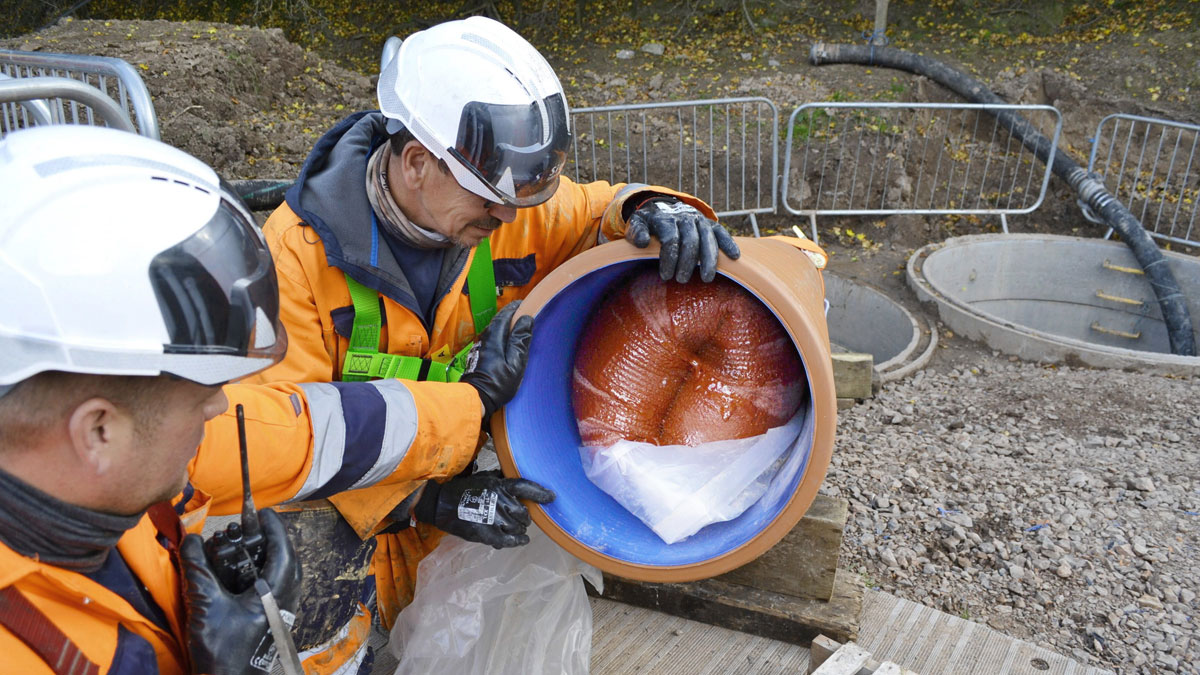
Arrival of the everted liner into the test sample pipes – Courtesy of Wessex Water
We now have ISO 11297, but in the absence of a worldwide recognised design method for the design of CIPP rising main liners, we commissioned an innovative design methodology from Dr Ian Bateman of Bateman Consultants Pty Ltd in Australia, which allowed us to dictate the mechanical properties for clarity and comparison. The design of thickness provided by the supplier was assessed and compared against the following:
- Short term pressure rating.
- Long term pressure rating.
- Surge pressure (occasional).
- Surge pressure (cyclic).
- Surge pressure (vacuum).
- External loads.
The designs explored and encompassed concepts such as overcoming eversion frustration of liner thickness’ versus diameter and length of eversion and the possibility of a ‘liner on liner’ composite, to aggregate the design thickness required.
Taking into consideration the tests results, CCTV and sonar surveys and using the equations to confirm thickness design, the liner used was ‘Nordipipe W PP’ by Norditube Ltd, as an ISO 11295 Class A ‘ Independent’, fully structural liner. The liner was made of 4 layers of ECR glass epoxy liner, equating to a wall thickness of 9mm after cure.
The designs allowed for a maximum operational pressure (MOP) of 8 bar down to an absolute vacuum of -1 bar. The MOP in the existing rising mains, including surge, was well below this value. Should the host pipe eventually corrode and subject the liner to a hydrostatic high tidal load, and for any reason the syphon CIPP lining was emptied, the short term and long-term flexural conditions were also computed. In addition, fatigue due to cyclic loading was also a consideration.
Another challenging element in this project was the number of 22.5° bends and the concern of removing compacted heavy mineral detritus, whilst not using excessive jetting pressures that could damage the host pipe. A large capacity water tank was brought to site and was constantly being filled with clean water to gently displace and purge the main. To achieve the required cleanness, OnSite Ltd used an extraction method integrating balanced air scour amongst other techniques, to clean the riser suitably for the pressure liner.
The total head required to evert the liners was 13m above rising main invert. This was achieved by installing a scaffold tower of 10m high. The liners were slowly everted through the main over a distance of 100m from the SPS side, constantly displacing the clean purging water surcharge as the liner went into the receiving shaft, which was pumped away. The curing time was approximately 10 hours and each main was pressure tested once cured.
Several twin wall plastic bends led the liner up above ground into a system of straight pipe, to provide test samples for indicative mechanical property testing. These were conveyed to a laboratory in Germany, where Bateman Consultants Pty Ltd, specified tests to align with his pressure main designs.
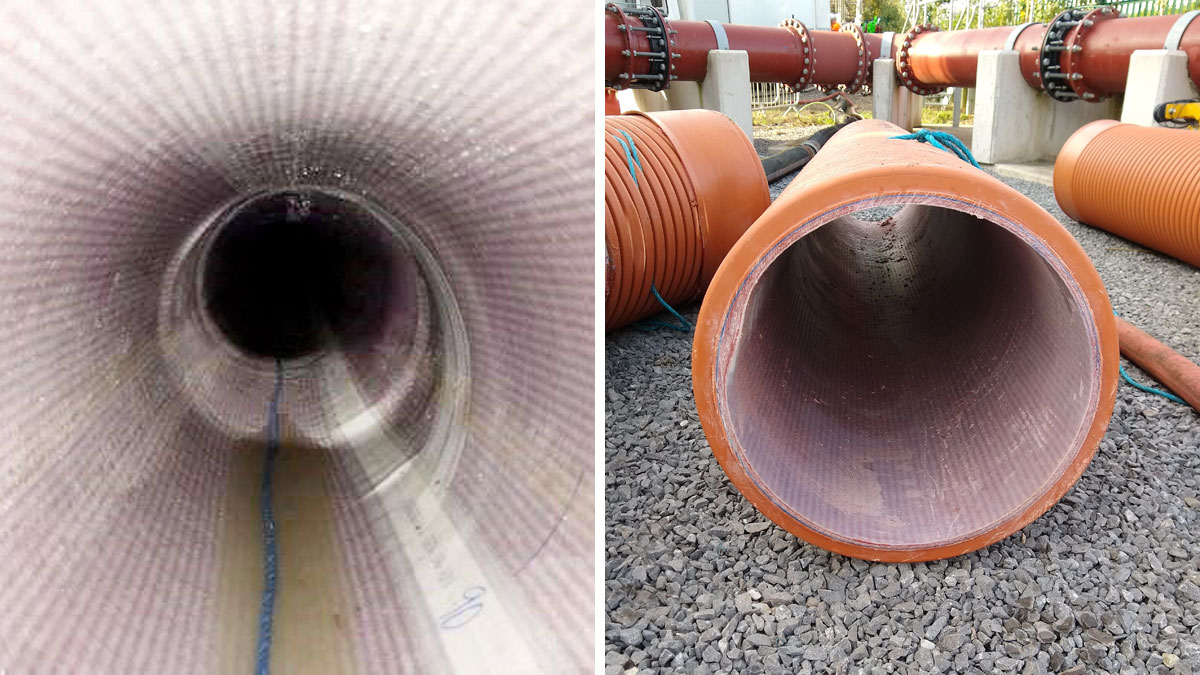
(left) Post CCTV survey of cured liner and (right) test sample pipes cured liner – Courtesy of Wessex Water
Tests and results
Four tests were carried out post-installation of the CIPP liner – CCTV survey to visually inspect the liner, pressure test, burst testing and mechanical property of the liner samples. The acceptance criteria is that the measured value to be equal to or greater than the design values.
The CCTV inspection showed few wrinkles around the bends as expected, but within the limits. The wrinkles along the mains were also within ISO 11297 limitations. The ends of the liner were sealed with a Weko seal end finish.
The rising mains were pressure tested for 1 hour at 5.4 bar, 1.9 bar higher than the current MOP. Both mains passed the test without any variances.
The mechanical properties of the liner were tested in Germany, IKT Laboratory. The test samples were cut into smaller specimens and were tested for initial circumferential tensile wall strength (σc), initial failure pressure (P0), flexural modulus testing (E1) and thickness testing (t). These tests were carried out using ISO 10467:2018 and ISO 11296-4:2018 standards. The results shown below are the mean value of five specimens for one of the mains. The tensile wall strength measured was 257 N/mm, the initial failure pressure 11 bar, the flexural modulus 8,775 MPa and thickness of 7.8mm.
The design values for the liners were 250 N/mm, 8 bar, 6,000 MPa and minimum thickness of 8.3mm respectively. The desired operating life of the liner was designed for 80 years.

Initial circumferential tensile wall strength, initial failure pressure test and thickness results from IKT, Germany
Conclusion
During all steps in the process safety was of paramount importance – protection around working close to the river, the potential for flooding and falls, risk assessments and internal negotiations were undertaken. No instances arose which caused any concern during the works. All H&S legislation and CDM procedures were recognised. All aspects of legislative compliance were addressed from colleagues across Wessex Water and OnSite Ltd. Good working relationships were also established with the lining contractor OnSite, lining supplier Norditube, lining designer Ian Bateman Consultants, Wessex Water construction and sewerage operations teams.
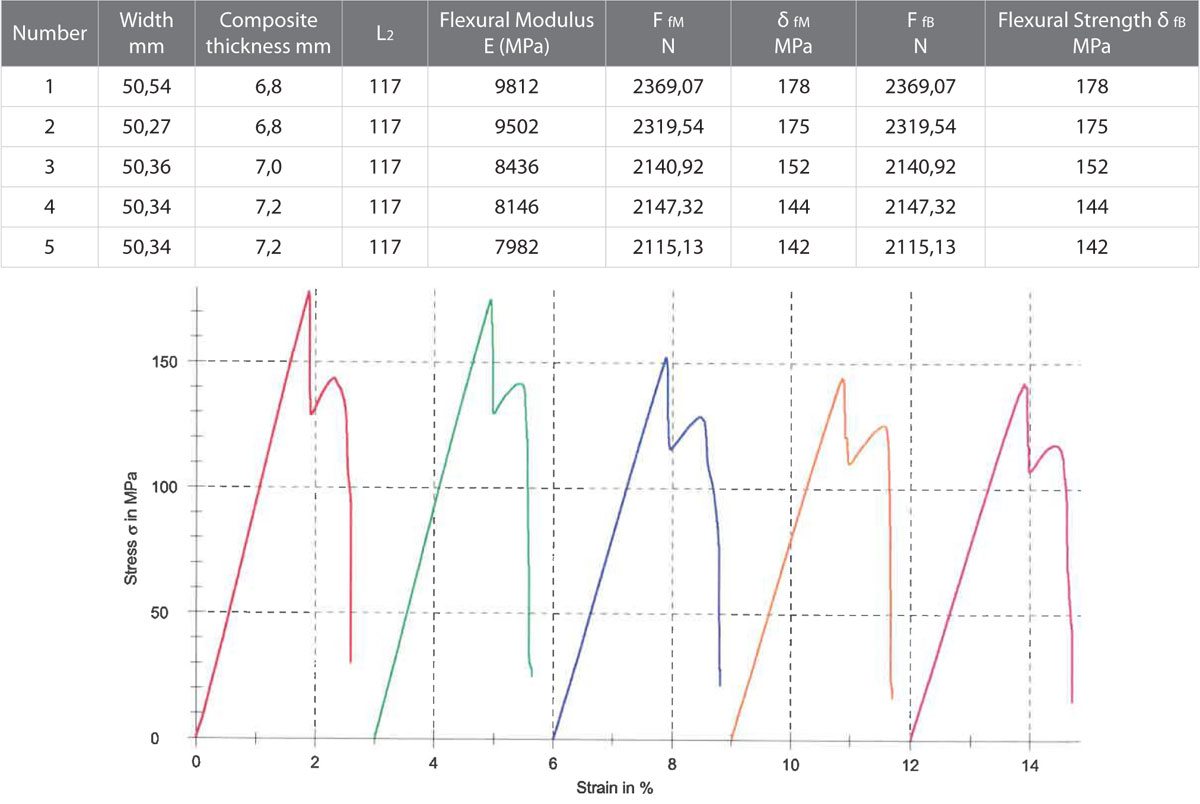
Flexural modulus results from IKT, Germany
The test results came back all satisfactory and the liner exceeded all the design parameters. The second phase of the project (lining works) were completed on programme over a period of 3 weeks in October 2020.
The submarine eversion technique used to overcome the highly fluctuating tidal threat is believed to be the first in the UK water history. This solution had been estimated with a range of £540k-£660k and was delivered within the budget.
It saved the company approximately 40% compared to original proposal of horizontal directional drilling.


